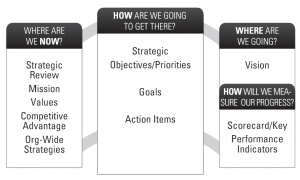Some organizations get stumped during the beginning steps of how to write a strategic plan. Strategic planning can definitely seem daunting with all the guides, recommendations, books, and consultants out there telling you to do it one way or another. Sometimes the best thing to do is step back and take a look at the key elements of a strategic plan. Not to oversimplify the planning process, but by dividing a strategic plan into four areas, you can clearly see how to pieces fit together.
The four pieces of the puzzle are found in these questions:
- Where are we now?
- Where are we going?
- How will we get there?
- How will we measure our progress?
Each area has certain elements to show you how and where things fit. Below is a bird’s-eye view of the elements of a strategic plan.

What matters most is having a strategy and, therefore, an effective strategic plan. An effective plan and execution process require the following attributes:
- Purpose-driven: A plan based on a mission and a real, true competitive advantage is key. Without it, what’s the point of the plan or the organization?
- Integrated: Each element supports the next. No objectives are disconnected from goals, and no strategies sit all alone.
- Systematic: Don’t think of the plan as one big document. Instead, give it life by break it into executable parts.
- Dynamic: The plan isn’t a static document but a living one.
- Holistic: All areas of the organization are included. Don’t plan based on departments first because you risk limiting your thinking. Plan by thinking about the organization as a whole entity and then implement on a department-by-department basis.
- Understandable: Everyone gets it. If anyone, from the top of the organization to the bottom, doesn’t understand the plan or how he or she fits in, it won’t work.
- Realistic: You can implement the plan. Don’t over plan. Make sure you have the resources to support the goals you decide to focus on.












Basics of Action plan